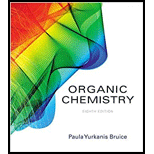
(a)
Interpretation:
The major product obtained by elimination when the given
Concept Introduction:
Zaitsev’s Rule:
States that the more substituted
(b)
Interpretation:
The major product obtained by elimination when the given alkyl halide reacts with hydroxide ion has to be identified.
Concept Introduction:
Zaitsev’s Rule:
States that the more substituted alkene is obtained when a hydrogen from is removed from the
(c)
Interpretation:
The major product obtained by elimination when the given alkyl halide reacts with hydroxide ion has to be identified.
Concept Introduction:
Zaitsev’s Rule:
States that the more substituted alkene is obtained when a hydrogen from is removed from the
Want to see the full answer?
Check out a sample textbook solution
Chapter 9 Solutions
ORGANIC CHEMISTRY-W/S.G+SOLN.MANUAL
- Which of the following will not be the product of the reaction of an alkene with hot potassium permanganate? An aldehyde A ketone A carboxylic acid Carbon dioxidearrow_forward3-Hexanone can be synthesized from butanal and ethane using a Grignard reaction. The first step must be O creation of a carbocation O protonation of an oxygen nucleophilic attack of the aldehyde free radical halogenation preparation of an acetylidearrow_forwardGive the main organic product that would form after the following reaction. OMe OMe H₂O H*arrow_forward
- Which of the following will form a tertiary ROH after reacting with CH3MgBr? a Acetone b Acetaldehyde c Ethanol d Ethanoic acidarrow_forwardWhat is the major product for each of the following reactions? (If an enol is created, write both the enol and keto products. If both ortho and para products are made, write both.)arrow_forwardhelparrow_forward
- Which of the following alkene reactions has a charged, cyclic reactive intermediate? Hydroboration Hydration Hydrohalogenation Halogenation Catalytic hydrogenationarrow_forward.Which one of the following molecules can react as electrophile in reactions with alkenes? CH3OH NaCI HCI KCN NaCI O HCI O KCN O CH3OHarrow_forwardWhich carbon will attack the alkyl halide (methyl iodide) in the major organic product of the following substitution reaction? B H₂ CH3 A D 1) LDA, THF 2) CHẠI C A B ں 000 Darrow_forward
- 5. What is the structure of an intermediate in the methyl shift rearrangement reaction shown in the box? A) C) B H₂SO4, H₂O B) D) OHarrow_forwardWhich of the following sequences of reactions would convert toluene to 2-bromo-4-cyanotoluene? Bromination, nitration, reduction, diazotization, reaction with cyanide anion Bromination, nitration, diazotization, reduction , reaction with cyanide anion Nitration, bromination, reduction, diazotization, reaction with cyanide anion Nitration, bromination, diazotization, reduction, reaction with cyanide anionarrow_forwardWhat is the product of the reaction of ethyl bromide with each of the following nucleophiles? CH3CH2CH2O- CH3C≡C- (CH3)3Narrow_forward
- Chemistry: Matter and ChangeChemistryISBN:9780078746376Author:Dinah Zike, Laurel Dingrando, Nicholas Hainen, Cheryl WistromPublisher:Glencoe/McGraw-Hill School Pub Co
 Introduction to General, Organic and BiochemistryChemistryISBN:9781285869759Author:Frederick A. Bettelheim, William H. Brown, Mary K. Campbell, Shawn O. Farrell, Omar TorresPublisher:Cengage Learning
Introduction to General, Organic and BiochemistryChemistryISBN:9781285869759Author:Frederick A. Bettelheim, William H. Brown, Mary K. Campbell, Shawn O. Farrell, Omar TorresPublisher:Cengage Learning
 Macroscale and Microscale Organic ExperimentsChemistryISBN:9781305577190Author:Kenneth L. Williamson, Katherine M. MastersPublisher:Brooks Cole
Macroscale and Microscale Organic ExperimentsChemistryISBN:9781305577190Author:Kenneth L. Williamson, Katherine M. MastersPublisher:Brooks Cole



